Patriot Relics
Silver Member
Hey guys,
Been overseas for 2 weeks and have been itching to get back to the lowcountry and knock the dust of the CTX. While I would have been perfectly happy to walk away with a flat button, I could never have predicted a night like this. This particular site has proven to be a great spot to meet other diggers on TNet. Over the course of the last month, we have had multiple group hunts with amazing success. Affectionately known as the watermelon patch, the dirt is packed with 300 years of history and continues to produce. The evening started out as most do, surface pottery, glass, and brick shards- the normal indicators for a killer site. Given the volume of targets and age of the site, everything dug ends up in my pouch for later identification. After arriving home I had no idea what I had dug. As I was working through my round stuff pocket, I noticed the familiar look of pewter. While only a partial, I carefully tooth picked away the corrosion hoping for a design of some sort...6...7!
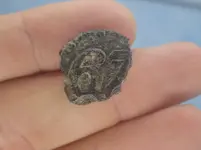
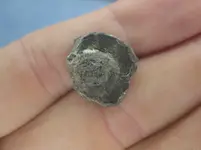
First Revolutionary War button of 2016, and finally an end to a 1 year regimental drought. Curiously, the 67th Regiment of Foot did not serve in North America during the war although 1 other example is noted in Troiani's book as being recovered in SC. Perhaps the soldier was attached to another unit during the occupation.
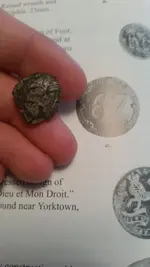
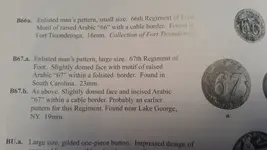
At this point I am already running around the kitchen, until I notice a familiar shape in the misc pocket-rectangular and made of brass. May have dug my first plate? After a bit of careful cleaning, my heart started pounding. Could this actually be what I think it is...holy **** its a Charleston Slave TAG! 1837 Servant #573. For me there are no words to express how it feels holding such a piece of history. The stories this discarded object could tell- stories which would have been lost after the site is covered in concrete.
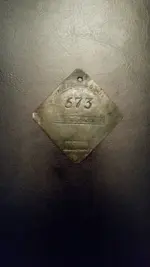
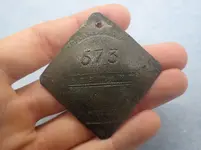
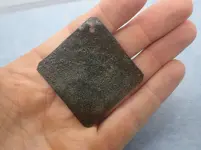
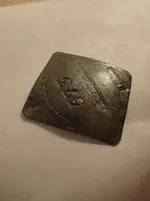
Among the other digs was a curious pewter spoon with an unknown benchmark, flat buttons, round balls, and a tiny pewter heart. Any ID help with the spoon is great appreciated.
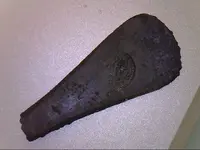
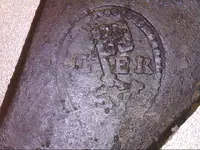
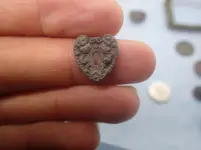
Certainly a night I will never forget- Rev War Regimental and a Charleston Slave tag at one site. This is why we spend the hours we do digging and swinging. As always, thanks for looking and get out there and save the next piece of history.
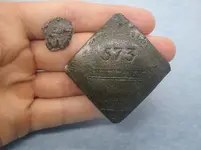
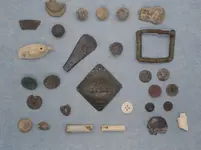
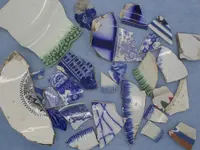
Update- After 48 hours in oil and a light brushing I am happy with the balance of patina and corrosion...after all its been in the ground for 179 years . Thanks to everyone for the kind words and for giving this history the attention it deserves.
. Thanks to everyone for the kind words and for giving this history the attention it deserves.
After a bit of research I have been able to confirm the tag was manufactured by Charleston silversmith William M. Rouse. He apprenticed until 1834 as a silversmith under John Ewan and subsequently went into business for himself. In 1836 he was awarded the city contract for manufacturing tags. Rouse's tags are unique in that he used a series of small dots around the stamped occupations on his badges from the 1830s. He continued making badges until 1840, size though growing increasingly smaller due to the increased cost of materials or diminishing profit margins. In 1837 he manufactured 3722 tags for a total contract of $8,141. Unfortunately the trail goes cold regarding the poor soul who wore the tag. All records were lost after the Civil War-
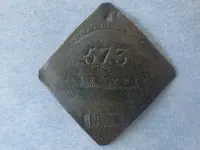
Been overseas for 2 weeks and have been itching to get back to the lowcountry and knock the dust of the CTX. While I would have been perfectly happy to walk away with a flat button, I could never have predicted a night like this. This particular site has proven to be a great spot to meet other diggers on TNet. Over the course of the last month, we have had multiple group hunts with amazing success. Affectionately known as the watermelon patch, the dirt is packed with 300 years of history and continues to produce. The evening started out as most do, surface pottery, glass, and brick shards- the normal indicators for a killer site. Given the volume of targets and age of the site, everything dug ends up in my pouch for later identification. After arriving home I had no idea what I had dug. As I was working through my round stuff pocket, I noticed the familiar look of pewter. While only a partial, I carefully tooth picked away the corrosion hoping for a design of some sort...6...7!


First Revolutionary War button of 2016, and finally an end to a 1 year regimental drought. Curiously, the 67th Regiment of Foot did not serve in North America during the war although 1 other example is noted in Troiani's book as being recovered in SC. Perhaps the soldier was attached to another unit during the occupation.


At this point I am already running around the kitchen, until I notice a familiar shape in the misc pocket-rectangular and made of brass. May have dug my first plate? After a bit of careful cleaning, my heart started pounding. Could this actually be what I think it is...holy **** its a Charleston Slave TAG! 1837 Servant #573. For me there are no words to express how it feels holding such a piece of history. The stories this discarded object could tell- stories which would have been lost after the site is covered in concrete.




Among the other digs was a curious pewter spoon with an unknown benchmark, flat buttons, round balls, and a tiny pewter heart. Any ID help with the spoon is great appreciated.



Certainly a night I will never forget- Rev War Regimental and a Charleston Slave tag at one site. This is why we spend the hours we do digging and swinging. As always, thanks for looking and get out there and save the next piece of history.



Update- After 48 hours in oil and a light brushing I am happy with the balance of patina and corrosion...after all its been in the ground for 179 years
 . Thanks to everyone for the kind words and for giving this history the attention it deserves.
. Thanks to everyone for the kind words and for giving this history the attention it deserves.After a bit of research I have been able to confirm the tag was manufactured by Charleston silversmith William M. Rouse. He apprenticed until 1834 as a silversmith under John Ewan and subsequently went into business for himself. In 1836 he was awarded the city contract for manufacturing tags. Rouse's tags are unique in that he used a series of small dots around the stamped occupations on his badges from the 1830s. He continued making badges until 1840, size though growing increasingly smaller due to the increased cost of materials or diminishing profit margins. In 1837 he manufactured 3722 tags for a total contract of $8,141. Unfortunately the trail goes cold regarding the poor soul who wore the tag. All records were lost after the Civil War-

Last edited:
Upvote
112





 banner
banner